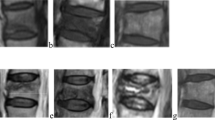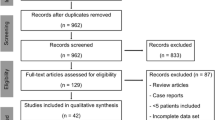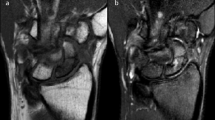Abstract
Objectives
To assess how pars interarticularis fracture characteristics on T1-VIBE and STIR MRI relate to healing and identify anatomical parameters that may impact healing.
Materials and methods
A retrospective review of an MRI series of lumbar pars interarticularis injuries in elite athletes over a 3-year period. Fracture configurations, signal intensities and anatomical parameters were recorded by two radiologists. Statistical analysis employed multilevel mixed-effects linear regressions, adjusted for repeated measures and baseline covariates.
Results
Forty-seven lumbar pars interarticularis injuries among 31 athletes were assessed. On final scans for each athlete, 15% (7/47) injuries had worsened, 23% (11/47) remained stable, 43% (20/47) partially healed and 19% (9/47) healed completely. Healing times varied, quickest was 49 days for a chronic fracture in a footballer. Bone marrow oedema signal was highest in worsened fractures, followed by improved, and lowest in stable fractures. As healing progressed, T1-VIBE signal at the fracture line decreased. Bone marrow oedema and fracture line signal peaked at 90–120 days before decreasing until 210–240 days. Fractures with smaller dimensions, more vertical orientation and a longer superior articular facet beneath were significantly associated with better healing (p < 0.05).
Conclusion
Most diagnosed athletic pars interarticularis injuries improve. Normalising T1-VIBE signal at the fracture line is a novel measurable indicator of bony healing. Contrastingly, bone marrow oedema signal is higher in active fractures irrespective of healing or deterioration. Injuries initially perceived as worsening may be exhibiting the normal osteoclastic phase of healing. Better outcomes favour smaller, vertical fractures with a longer superior articular facet beneath.



Similar content being viewed by others
References
Tawfik S, Phan K, Mobbs RJ, Rao PJ. The incidence of pars interarticularis defects in athletes. Glob Spine J. 2020;10(1):89–101.
Gregory PL, Batt ME, Kerslake RW. Comparing spondylolysis in cricketers and soccer players. Br J Sports. 2004;38:737–42.
Selhorst M, Allen M, McHugh R, MacDonald J. Rehabilitation considerations for spondylolysis in the youth athlete. Int J Sports Phys Ther. 2020;15:287–300.
Choi JH, Ochoa JK, Lubinus A, Timon S, Lee Y-P, Bhatia NN. Management of lumbar spondylolysis in the adolescent athlete: a review of over 200 cases. Spine J. 2022;22:1628–33.
Fredrickson BE, Baker D, McHolick WJ, Yuan HA, Lubicky JP. The natural history of spondylolysis and spondylolisthesis. J Bone Jt Surg - Ser A. 1984;66(5):699–707.
Goetzinger S, Courtney S, Yee K, Welz M, Kalani M, Neal M. Spondylolysis in young athletes: an overview emphasizing nonoperative management. J Sport Med (Hindawi Publ Corp). 2020;2020:9235958.
Chung CC, Shimer AL. Lumbosacral spondylolysis and spondylolisthesis. Clin Sports Med. 2021;40:471–90.
Rush JK, Astur N, Scott S, Kelly DM, Sawyer JR, Warner WC. Use of magnetic resonance imaging in the evaluation of spondylolysis. J Pediatr Orthop. 2015;35(3):271–5.
Sairyo K, Katoh S, Takata Y, Terai T, Yasui N, Goel VK, et al. MRI signal changes of the pedicle as an indicator for early diagnosis of spondylolysis in children and adolescents: a clinical and biomechanical study. Spine (Phila. Pa. 1976). 2006;31(2):206-11.
Koh E, Walton ER, Watson P. VIBE MRI: an alternative to CT in the imaging of sports-related osseous pathology? Br J Radiol. 2018;91:20170815.
Cheung KK, Dhawan RT, Wilson LF, Peirce NS, Rajeswaran G. Pars interarticularis injury in elite athletes - the role of imaging in diagnosis and management. Eur J Radiol. 2018;108:28–42.
Ang EC, Robertson AF, Malara FA, O’Shea T, Roebert JK, Schneider ME, et al. Diagnostic accuracy of 3-T magnetic resonance imaging with 3D T1 VIBE versus computer tomography in pars stress fracture of the lumbar spine. Skeletal Radiol. 2016;45:1533–40.
Hollenberg GM, Beattie PF, Meyers SP, Weinberg EP, Adams MJ. Stress reactions of the lumbar pars interarticularis: the development of a new MRI classification system. Spine (Phila Pa 1976). 2002;27(2):181–6.
Rofsky NM, Lee VS, Laub G, Pollack MA, Krinsky GA, Thomasson D, et al. Abdominal MR imaging with a volumetric interpolated breath-hold examination. Radiology. 1999;212:876–84.
Masharawi Y, Dar G, Peleg S, Steinberg N, Alperovitch-Najenson D, Salame K, et al. Lumbar facet anatomy changes in spondylolysis: a comparative skeletal study. Eur Spine J. 2007;16(7):993–9.
Koslosky E, Gendelberg D. Classification in brief: the Meyerding classification system of spondylolisthesis. Clin Orthop Relat Res. 2020;478:1125–30.
Weishaupt D, Zanetti M, Boos N, Hodler J. MR imaging and CT in osteoarthritis of the lumbar facet joints. Skeletal Radiol. 1999;28:215–9.
Hallgren KA. Computing inter-rater reliability for observational data: an overview and tutorial. Tutor Quant Methods Psychol. 2012;8:23–34.
Singh SP, Rotstein AH, Saw AE, Saw R, Kountouris A, James T. Radiological healing of lumbar spine stress fractures in elite cricket fast bowlers. J Sci Med Sport. 2021;24(2):112–5.
Johnson LC, Stradford HT, Geis RW, Dineen JR, Kerley E. Histogenesis of stress fractures. J Bone Jt Surg [Am]. 1963;45:1542.
Yamashita K, Sakai T, Takata Y, Hayashi F, Tezuka F, Morimoto M, et al. Utility of STIR-MRI in detecting the pain generator in asymmetric bilateral pars fracture: a report of 5 cases. Neurol Med Chir (Tokyo). 2018;58(2):91–5.
Borg B, Modic MT, Obuchowski N, Cheah G. Pedicle marrow signal hyperintensity on short tau inversion recovery- and T2-weighted images: prevalence and relationship to clinical symptoms. Am J Neuroradiol. 2011;32(9):1624–31.
Sims K, Kountouris A, Stegeman JR, Rotstein AH, Beakley D, Saw AE, et al. MRI bone marrow edema signal intensity: a reliable and valid measure of lumbar bone stress injury in elite junior fast bowlers. Spine (Phila Pa 1976). 2020;45(18):E1166–71.
Nakamae T, Kamei N, Tamura T, Kanda T, Nakanishi K, Adachi N. Quantitative assessment of bone marrow edema in adolescent athletes with lumbar spondylolysis using contrast ratio on magnetic resonance imaging. Asian Spine J. 2021;15(5):682–7.
Dunn AJ, Campbell RSD, Mayor PE, Rees D. Radiological findings and healing patterns of incomplete stress fractures of the pars interarticularis. Skeletal Radiol. 2008;37:443–50.
Ganiyusufoglu AK, Onat L, Karatoprak O, Enercan M, Hamzaoglu A. Diagnostic accuracy of magnetic resonance imaging versus computed tomography in stress fractures of the lumbar spine. Clin Radiol. 2010;65(11):902–7.
Campbell RSD, Grainger AJ, Hide IG, Papastefanou S, Greenough CG. Juvenile spondylolysis: a comparative analysis of CT, SPECT and MRI. Skeletal Radiol. 2005;34:63–73.
Katakura M, Mitchell AWM, Lee JC, Calder JD. Is it time to replace CT with T1-VIBE MRI for the assessment of musculoskeletal injuries? Bone Joint J. 2020;102-B:1435–7.
Mathews JD, Forsythe AV, Brady Z, Butler MW, Goergen SK, Byrnes GB, et al. Cancer risk in 680 000 people exposed to computed tomography scans in childhood or adolescence: data linkage study of 11 million Australians. BMJ. 2013;346:f2360–f2360.
Biswas D, Bible JE, Bohan M, Simpson AK, Whang PG, Grauer JN. Radiation exposure from musculoskeletal computerized tomographic scans. J Bone Joint Surg Am. 2009;91:1882–9.
Warncke ML, Wiese NJ, Tahir E, Sehner S, Heinemann A, Regier M, et al. Highly reduced-dose CT of the lumbar spine in a human cadaver model. PLoS ONE. 2020;15:e0240199.
Author information
Authors and Affiliations
Corresponding author
Ethics declarations
Conflict of interest
The authors declare no competing interests.
Additional information
Publisher's Note
Springer Nature remains neutral with regard to jurisdictional claims in published maps and institutional affiliations.
Rights and permissions
Springer Nature or its licensor (e.g. a society or other partner) holds exclusive rights to this article under a publishing agreement with the author(s) or other rightsholder(s); author self-archiving of the accepted manuscript version of this article is solely governed by the terms of such publishing agreement and applicable law.
About this article
Cite this article
Watura, C., Mitchell, A.W.M., Fahy, D. et al. T1-VIBE and STIR MRI of lumbar pars interarticularis injuries in elite athletes: fracture characterisation and potential prognostic indicators. Skeletal Radiol 53, 489–497 (2024). https://doi.org/10.1007/s00256-023-04437-x
Received:
Revised:
Accepted:
Published:
Issue Date:
DOI: https://doi.org/10.1007/s00256-023-04437-x




